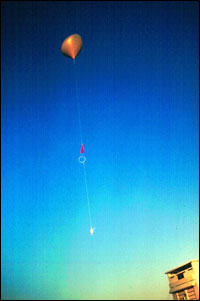Errors in the measurement of global warming corrected

Weather balloon. Courtesy of NOAA
The effect of the sun’s heat on weather balloons largely accounts for a data discrepancy that has long contributed to a dispute over the existence of global warming, according to a report by scientists at Yale University and the National Oceanic and Atmospheric Administration (NOAA).
The report, to be published in the journal Science, says that direct heat of the sun on temperature probes of the weather balloon (radiosonde) probably explains the discrepancy between reports showing that atmospheric temperatures have been unchanged since the 1970’s, while temperatures at the Earth’s surface are rising.
For the last 40 years radiosonde temperature information has been collected twice each day from stations around the world at local times that correspond to 00:00 and 12:00 Greenwich Mean Time. Some measurements were taken in daylight, others in darkness.
“Even though models predict a close link between atmospheric and surface temperatures, there has been a large difference in the actual measurements,” said Steven C. Sherwood, associate professor of geology and geophysics at Yale, and lead author. “This has muddied the interpretation of reported warming.” Most scientists have concluded the surface warming has partly resulted from a buildup of greenhouse gases in the atmosphere.
The key to the error in climate change estimates lay in instrument design, according to this study. With exposed sensors, measurement taken in daylight read too warm, and while solar heating had a measurable impact on the earlier designs, the effect became negligible in more recent designs.
“It’s like being outside on a hot day — it feels hotter when you are standing in the direct sun than when you are standing in the shade,” said Sherwood. “We can’t hang our hats on the old balloon numbers.”
After taking this problem into account, the researchers estimate there has been an increase of 0.2 degree Celsius (°C) in the average global temperature per decade for the last thirty years. Over the next century, global surface temperatures are expected to increase by 2 to 4°C. However, year-to-year and region to region increases may vary considerably, with a smaller increase in the tropics but 10 degrees or more possible in some Polar Regions.
“Unfortunately, the warming is in an accelerating trend — the climate has not yet caught up with what we’ve already put into the atmosphere,” said Sherwood. “There are steps we should take, but it seems that shaking people out of complacency will take a strong incentive.”
Media Contact
More Information:
http://www.yale.eduAll latest news from the category: Earth Sciences
Earth Sciences (also referred to as Geosciences), which deals with basic issues surrounding our planet, plays a vital role in the area of energy and raw materials supply.
Earth Sciences comprises subjects such as geology, geography, geological informatics, paleontology, mineralogy, petrography, crystallography, geophysics, geodesy, glaciology, cartography, photogrammetry, meteorology and seismology, early-warning systems, earthquake research and polar research.
Newest articles

Sea slugs inspire highly stretchable biomedical sensor
USC Viterbi School of Engineering researcher Hangbo Zhao presents findings on highly stretchable and customizable microneedles for application in fields including neuroscience, tissue engineering, and wearable bioelectronics. The revolution in…

Twisting and binding matter waves with photons in a cavity
Precisely measuring the energy states of individual atoms has been a historical challenge for physicists due to atomic recoil. When an atom interacts with a photon, the atom “recoils” in…

Nanotubes, nanoparticles, and antibodies detect tiny amounts of fentanyl
New sensor is six orders of magnitude more sensitive than the next best thing. A research team at Pitt led by Alexander Star, a chemistry professor in the Kenneth P. Dietrich…





















